Paramedics in Australia
A paramedic in Australia is a health care professional who responds to and treats all types of medical and trauma emergencies outside of a hospital setting before and during transportation to an appropriate medical facility. Paramedics also work in the inter-facility transport environment where a paramedic will continue or upgrade medical care to a higher level while transporting a patient from one healthcare facility to another. Paramedics are able to treat patients in the pre-hospital setting, and can transport them to a hospital-based emergency department if deemed necessary. In Australia, use of the term paramedic is lawfully restricted to the use of those registered with AHPRA.
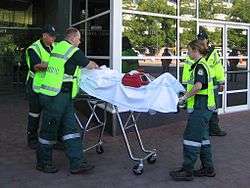
Definition of a paramedic
Starting in December 2018, The titles ‘paramedic’ and ‘paramedicine’ became protected by law and only people registered with the Paramedicine Board of Australia (National Board) can legally call themselves a paramedic. According to the Paramedicine Board of Australia "From 1 December 2018 paramedicine becomes a nationally regulated profession under the Health Practitioner Regulation National Law (National Law) and the titles ‘paramedic’ and ‘paramedicine’ will become protected by law. This means that from 1 December 2018, only people who are registered with the Paramedicine Board of Australia (the Board) or who have applied for registration before 1 December 2018 will be able to lawfully call themselves a paramedic." Some people with exceptional circumstances have until February 28, 2019 to register if they wish to use the title of "Paramedic". Beyond that date, any person calling themselves a paramedic may be charged with an offence under National Law, (s 113(1)(a), s 116(1)(b), s 116(1)(c)and/or s 116(1)(d). [1]
Prior to being nationally regulated, the title paramedic was generally used to identify a person with a diploma or bachelor's degree in paramedicine. Most were employed by ambulance services, although those engaged in emergency health care in areas such as industrial sites or volunteer first aid services sometimes referred to themselves as a paramedic.
Some states and territories did have protection of title legislation to protect the use of the title of paramedic in that state to those who are qualified to use it (e.g. Health Services Amendment (Paramedics) Bill 2015 (NSW)). The qualifications were not specific educational qualifications but are generally those employed by their state ambulance service or those holding a qualification such as paramedic degree.
- Australian paramedics at work
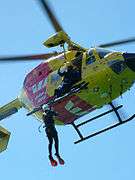
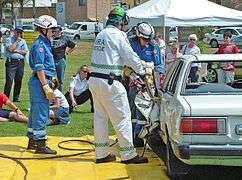
Education and training
The Australian government indirectly regulates paramedic training by means of a series of nationally recognised numbered certificates through the Australian Qualifications Framework, intended to provide a relatively common level of competencies. Regardless, local standards are regulated by state governments, and standards and definitions of terms vary widely between states. Many individuals possessing Certificates I-III may work in industrial first aid, for commercial first aid companies, or as non-emergency transporters or emergency ambulance services (particularly as volunteers). Possession of a Diploma of Health Science or a Bachelor of Paramedicine is regarded as the minimum entry level for emergency work in most statutory ambulance services, although some ambulance services require much higher qualifications. Apart from paramedics, other titles are used by some organizations for emergency medical response personnel. First responders are sometimes utilized in remote areas to provide advanced first aid training until paramedics arrive. Transport officers work in a non emergency setting, usually transporting stable patients from one health care facility to another, or providing transport for non-ambulatory people to prearranged medical appointments at a health care facility.
First responder
A Certificate II in Emergency Medical Response is used by some organisations. The term is non-specific and unregulated, and is used by private first aid companies, volunteer organisations, workplaces and State ambulance services to describe many levels of advanced first aid training.[2]
Patient transport officers
Patient transport officers must, at a minimum, complete a course of training that will earn them a nationally recognised Certificate III in Non-Emergency Patient Transport. Again, the use of the term is unregulated.[3]
Ambulance transport officer/attendant
Generally speaking, the statutory ambulance services in Australia require training to a Certificate IV level as the entry level for basic life support providers.[4] The one exception to this is the State of Queensland, which still permits entry at the Certificate I level, or at Certificate IV. Though in other states like Victoria a Diploma of Paramedical Science (Ambulance), is required to transport more acute patients. This is possible in either the state run ambulance service (AV), or in some of the private ambulance transport companies.
Paramedic
Paramedics in Australia's statutory ambulance services are all educated to advanced life support Level (ALS). The base qualification for a paramedic is a diploma or bachelor's degree (in health science, paramedic science, emergency health or paramedicine) or a postgraduate diploma (pre-master's – for health professionals converting to paramedicine).[5] Some paramedic degrees are dual, that is with another discipline, for example Bachelor of Paramedicine/Bachelor of Nursing.[6]
In some states, paramedics can still undergo an in-service (post employment) diploma or advanced diploma level of education. This involved on-the-job training using the nationally recognised diploma with several years of supervised practice. Post-employment training is slowly being phased out in most states of Australia, with New South Wales being one of the last to continue to use it in a limited way. Victoria and South Australia have completely ceased all in-service education, with other states gradually reducing post-employment training as the supply of graduate paramedics from universities meets industry demands.[7] Generally and increasingly, the standard for entry into practice requires graduation from a university.[8]
Intensive care, critical care or mobile intensive care ambulance paramedic
Intensive care (IC) paramedics, or mobile intensive care ambulance (MICA) paramedics, have completed post-graduate education that allows them to have a primary role of supporting paramedics by providing in-field stabilisation and mobile intensive care.[9] Graduates have completed a university-level post-graduate diploma in Intensive Care Paramedical Practice, Emergency Health (MICA Paramedic) or equivalent in addition to their base qualification and graduate (internship) program.
Graduate internship
Unlike educational programs in the United States, Canada and other countries, graduates from an Australian university degree in paramedicine are not usually considered 'road ready' by statutory ambulance authorities. Although their academic credential is internationally recognized, in order to be a fully recognized paramedic, University graduates must complete an 'internship year' with an EMS agency.[10] This can only be done once the graduate student has been hired by the EMS agency.
- Ambulances and more
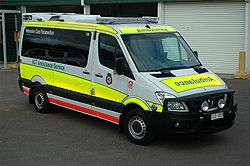
_313_CDI_MWB_van%2C_St_John_Ambulance_(2017-12-09).jpg)
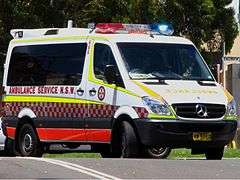
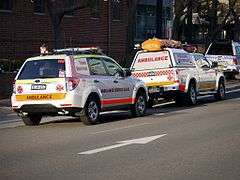
_01.jpg)
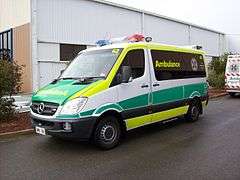

Clinical scope of practice
Please note that these terms and qualifications vary slightly between states. These are the minimum qualifications, but some states require more advanced training to hold these positions. For example, in Victoria, "Ambulance Transport Attendants" (ATA) (who primarily work for non-emergency private companies) are now required to hold a Diploma,[11] and the term "Ambulance Paramedic" (Victoria) can also be referred to as "Advanced Care Paramedic" (Queensland).
First responder
In some locations, volunteer first responders are used by ambulance services to begin basic treatment before a paramedic arrives. Their training is a high standard of advanced first aid.[12] In some states volunteer "Ambulance Officers" have similar training to First Responders.
Patient transport officer
Patient transport officers (PTOs), or ambulance transport officers, provide non-emergency patient transport. PTOs provide a pre-booked, non-urgent service that includes home to hospital and hospital to hospital transfers.[13] In some states, PTOs may occasionally be required to act as first responders to emergencies. This is usually limited to situations where it would take significantly longer for paramedics to arrive at the scene than a nearby patient transport crew, or where patients that are assessed to be low-risk and require a low level of care in transit. Also, as many patient transport ambulances carry a second stretcher, non-emergency ambulance officers can be utilised to assist emergency crews in incidents involving numerous casualties. In Victoria, PTOs & AAs will respond to Medium Acuity 000 calls that are dispatched through the ESTA Referral Service.
Ambulance officer / Ambulance transport attendant
This is the basic level of pre-hospital emergency care. These paramedics hold a Certificate IV Health Care (Ambulance) (previously known as Certificate IV in Emergency Care), or equivalent, and are trained in basic life support skills.
Paramedic
Paramedics practice includes all components of the basic life support level and the further enhancement of IV cannulation, drug therapy (oral, intramuscular injection (IM), intravenously (IV), narcotic pain relief, anti-emetics, cardiac arrest, respiratory drugs, etc.), fluid resuscitation, advanced airway management (usually a laryngeal mask airway [LMA], or endotracheal intubation and Cricothyroidotomy in Western Australia) and the maintenance of infusions. Paramedics perform extensive physical assessment, blood examinations (e.g. random glucose test), interpret electrocardiograms (ECG), SpO2, temperature, and provide care for a range of patients from the new born to the elderly.
Intensive care, critical care or mobile intensive care ambulance (MICA) paramedic
IC or MICA paramedics are able to practice intensive care procedures such as endotracheal intubation, surgical airways, rapid sequence intubation (RSI), nasotracheal intubation, chest tube insertion, and drug infusions (e.g. Adrenaline, Salbutamol, sedation, thrombolytics etc.). IC or MICA paramedics practice under clinical practice guidelines independently of medical control.[14] The Council of Ambulance Authorities is currently lobbying for an expanded scope of practice to permit more primary care by advance care paramedics, including the role of paramedic as independent practitioner.[15]
Rescue or special operations paramedic
Some ambulance services employ paramedics specially trained in rescue or special operations techniques.[16] Officers can be trained in areas such as road crash rescue, vertical rescue, confined space and trench rescue.[17] They learn navigation skills, four wheel driving, urban search and rescue, and chemical biological and radiological procedures.
Retrieval or flight paramedic
Retrieval or flight paramedics work on fixed wing and helicopter aircraft in many states, performing both emergency and routine transport operations. They are generally considered to be extremely highly trained in emergency medical care, but also aviation medicine, rescue and aviation emergencies. In some states this role is performed by a Flight Nurse or Flight Doctor with specialist qualifications in Intensive Care or Emergency Medicine who is then supported by a Flight Paramedic who is usually credentialed at IC or MICA level.
- Australian air ambulances
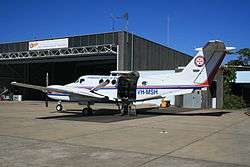
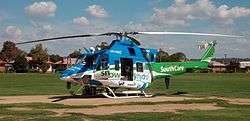
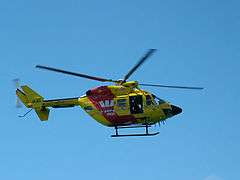
Employment
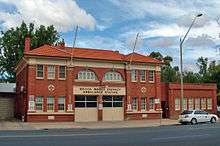
Paramedics are employed by various public and private service providers. The state run ambulance services are activated by the 000 (or 112 for mobile phones) emergency number. Paramedics may respond to medical incidents in a conventional ambulance, sedan, 4WD, rescue vehicle, helicopter, fixed-wing aircraft, motorcycle or even bicycle or foot at large public gatherings. There are also private transport ambulances which are crewed by Patient Transport Officers (or sometimes Ambulance Attendants and/or nurses). They generally transport non-emergency patients between hospitals and other health settings such as nursing homes.[18] In Australia paramedic salaries range to over $130,000 a year, depending on location, experience, supervisory responsibilities and overtime.
Professional organisations
Paramedics Australasia is one of two professional organisations that represent and deliver Professional Development for paramedics www.paramedics.org. The Australian and New Zealand College of Paramedicine (ANZCP) is the other.[19]
Industrial representation varies from state to state, the paramedic unions in Australia include the Ambulance Employees of Australia (AEA) which represents paramedics from South Australia, Queensland, Victoria and Western Australia. The Health Services Union is another in the industrial field.
The Emergency Medical Services Protection Association (EMSPA) represents a new chapter in legal and industrial representation and protection for paramedics and employees. EMSPA is a professional organisation representing nearly 2000 paramedics in New South Wales, Queensland, and Victoria in industrial and other work-related matters. Established in 2005 by ambulance officers seeking improved representation on employment-related matters, this association has been extremely successful in representing the rights and entitlements of ambulance officers since its inception and as a result continues to grow in membership numbers.[20]
History
Prior to the 1970s, most ambulance services in Australia were staffed by paid and volunteer staff called "bearers" or "ambulance bearers". Qualifications were often no more than possession of a first aid certificate or a home nursing course certificate. Some were trained to administer Trichloroethylene (an anesthetic/pain relief), while bandaging and splinting skills often formed the core of training sessions. In the 1970s Queensland commenced formal training blocks at the Ambulance Officer training Centre, while the Metropolitan Ambulance Service in Melbourne, Victoria developed the Mobile Intensive Care Ambulance (MICA) program. Over the next few years, some ambulance officers were trained in coronary care, allowing them to treat patients with semi automatic defibrillators. The use of semi automatic defibrillators and 3 lead ECG cardiac monitoring became standard as more were added to ambulances. By the 1990s Queensland Ambulance Service trained recruits in conjunction with South Brisbane TAFE. After completing a three-year course, graduates were presented with an associate Diploma in Heath Science (later a Diploma) and became "Qualified Ambulance Officers". Existing staff completed bridging courses. In the mid-2000s, universities began offering Bachelor of Paramedicine as a pathway to gaining employment with Australian ambulance services.
See also
- Help (Australian TV series)
References
- "Paramedicine Board of Australia – Fact sheet: Using the title 'paramedic' after 1 December 2018". Retrieved 2019-02-09.
- "Volunteers (QAS website)". Retrieved 2008-11-12.
- "Position Requirements (Medical Transport Services website)". Retrieved 2008-11-12.
- "Certificate IV (Swinburne University website)". Archived from the original on September 4, 2007. Retrieved 2008-11-12.
- "Paramedic Education Within Australian Universities, Appendix A" (PDF). Retrieved 2008-11-12.
- http://www.acu.edu.au/courses/640253
- http://www.ambulance.nsw.gov.au/employment/paramedic_recruitment.html
- "Paramedic Education Within Australian Universities pp2" (PDF). Retrieved 2008-11-12.
- "Mobile Intensive Care Ambulance Paramedic". Retrieved 2008-11-12.
- "Becoming a paramedic" SA Ambulance Service. 1997. Retrieved 12 January 2012.
- "Ambulance (Victoria University website)". Archived from the original on 2008-07-24. Retrieved 2008-11-12.
- "First Responder". Retrieved 2008-12-16.
- "Patient Transport Officer (Victoria State website)". Retrieved 2008-12-16.
- Victoria L. Fedor; Jacob L. Hafter (2003). EMS and the Law. Sudbury, Mass: Jones & Bartlett Publishers. ISBN 0-7637-2068-2.
- "The Rural and Regional Paramedic: Moving Beyond Emergency Response" (PDF). Retrieved 2015-02-22.
- http://www.ambulance.nsw.gov.au/media_publications/2010_pages/100107special.html
- "Nursing and Midwifery in Western Australia (govt website)". Retrieved 2008-12-16.
- "Ambulance Private website". Retrieved 2008-12-02.
- "The Australian & New Zealand College of Paramedicine". Retrieved 2013-10-11.
- "EMSPA Inc". Retrieved 2010-02-03.
External links
| Wikimedia Commons has media related to Paramedic. |